Using a Hydrological Model to Simulate the Performance and Estimate the Runoff Coefficient of Green Roofs in Semiarid Climates
Abstract
:1. Introduction
2. Materials and Methods
2.1. Experimental Set-Up
2.1.1. Test Facility
2.1.2. Description of Tested Green Roofs Specimens
2.1.3. Monitoring
2.2. Modeling
2.2.1. Hydrological Model
2.2.2. Assumptions
2.2.3. Inputs and Outputs
2.3. Data Analysis
3. Results
3.1. Calibration and Validation of the Model
3.1.1. Calibration Phase
3.1.2. Validation Phase
3.2. Performance Assessment
3.2.1. Irrigation Needs
3.2.2. Water Runoff
4. Conclusions
- IHMORS is capable of characterizing many different variables of green roofs, such as the geometry, vegetation, substrate type and depth, and drainage system. In particular IHMORS was successfully calibrated to 10 different specimens (and two more replicas of one of them).
- The calibrated model predicted the volumetric water content (VWC) dynamics of the 10 cm depth specimens quite well, especially those with no drainage layer. The estimated VWC was less accurate for the 5 and 20 cm specimens. The larger errors obtained for those specimens with stronger vegetation development suggest the necessity for a better understanding of the effects of the vegetation changes on the substrate, and the definition of modelling strategies to represent such changes.
- By means of the soil water content duration curve, the model can be used to estimate the number of days in which irrigation may be needed to preserve a target soil moisture. Such application shows how the 5 cm depth specimen with no drainage layer reaches substrate moisture values lower than the wilting point. During these days (~10% of the study period) irrigations should be considered.
- The simulation of the runoff coefficients using the model yields very reasonable results. For all the rain events, the lowest runoff coefficient was simulated for the 20 cm specimens. Moreover, small events (<3 mm) did not produce outflow from any specimen. Finally, the simulated runoff coefficients were directly proportional to the duration and the magnitude of the rainfall events.
Acknowledgments
Author Contributions
Conflicts of Interest
References
- Berndtsson, J.C. Green roof performance towards management of runoff water quantity and quality: A review. Ecol. Eng. 2010, 36, 351–360. [Google Scholar] [CrossRef]
- Novotny, V.; Ahern, J.; Brown, P. Water Centric Sustainable Communities: Planning, Retrofitting, and Building the Next Urban Environment; John Wiley & Sons: Hoboken, NJ, USA, 2010; ISBN 978-0-470-47608-6. [Google Scholar]
- Rossmiller, R.L. Stormwater Design for Sustainable Development; Mc Graw Hill Education: Columbus, OH, USA, 2014; ISBN 978-0071816526. [Google Scholar]
- Liu, K.; Baskaran, B. Thermal performance of green roofs through field evaluation. In Proceedings of the First North American Green Roof Infrastructure Conference, Awards and Trade Show, Chicago, IL, USA, 29–30 May 2003; pp. 1–10. [Google Scholar]
- Reyes, R.; Bustamante, W.; Gironás, J.; Pastén, P.A.; Rojas, V.; Suárez, F.; Vera, S.; Victorero, F.; Bonilla, C.A. Effect of substrate depth and roof layers on green roof temperature and water requirements in a semi-arid climate. Ecol. Eng. 2016, 97, 624–632. [Google Scholar] [CrossRef]
- Van Mechelen, C.; Dutoit, T.; Hermy, M. Adapting green roof irrigation practices for a sustainable future: A review. Sustain. Cities Soc. 2015, 19, 74–90. [Google Scholar] [CrossRef]
- Nektarios, P.A.; Amountzias, I.; Kokkinou, I.; Ntoulas, N. Green roof substrate type and depth affect the growth of the native species Dianthus fruticosus under reduced irrigation regimens. HortScience 2011, 46, 1208–1216. [Google Scholar]
- Issa, R.J.; Leitch, K.; Chang, B. Experimental heat transfer study on green roofs in a semiarid climate during summer. J. Constr. Eng. 2015, 2015, 960538. [Google Scholar] [CrossRef]
- Vera, S.; Bonilla, C.; Victorero, F.; Gironás, J.; Bustamante, W.; Rojas, M.V. Soluciones Integrales de Cubiertas Vegetales Sustentables para Edificios Comerciales-Industriales en Climas Semiaridos de Chile; Informe Técnico Final, Proyecto INNOVACHILE 12IDL2-13630; Departamento de Ingeniería y Gestión de la Construcción, Escuela de Ingeniería, Pontificia Universidad Católica de Chile: Santiago, Chile, 2014. [Google Scholar]
- Dvorak, B.; Volder, A. Plant establishment on unirrigated green roof specimens in a subtropical climate. AoB Plants 2013, 5, pls049. [Google Scholar] [CrossRef]
- Sample, D.J.; Heaney, J.P. Integrated management of irrigation and urban stormwater infiltration. J. Water Resour. Plan. Manag. 2006, 132, 362–373. [Google Scholar] [CrossRef]
- Houdeshel, C.D.; Hultine, K.R.; Johnson, N.C.; Pomeroy, C.A. Evaluation of three vegetation treatments in bioretention gardens in a semi-arid climate. Landsc. Urban Plan. 2015, 135, 62–72. [Google Scholar] [CrossRef]
- Berretta, C.; Poë, S.; Stovin, V. Moisture content behaviour in extensive green roofs during dry periods: The influence of vegetation and substrate characteristics. J. Hydrol. 2014, 511, 374–386. [Google Scholar] [CrossRef]
- Herrera, J.; Bonilla, C.A.; Castro, L.; Vera, S.; Reyes, R.; Gironás, J. A model for simulating the performance and irrigation of green stormwater facilities at residential scales in semiarid and Mediterranean regions. Environ. Model. Softw. 2017, 95, 246–257. [Google Scholar] [CrossRef]
- Li, Y.; Babcock, R.W., Jr. Green roof hydrologic performance and modeling: A review. Water Sci. Technol. 2014, 69, 727–738. [Google Scholar] [CrossRef] [PubMed]
- Feitosa, R.C.; Wilkinson, S. Modelling green roof stormwater response for different substrate depths. Landsc. Urban Plan. 2016, 153, 170–179. [Google Scholar] [CrossRef]
- Hilten, R.N.; Lawrence, T.M.; Tollner, E.W. Modeling stormwater runoff from green roofs with HYDRUS-1D. J. Hydrol. 2008, 358, 288–293. [Google Scholar] [CrossRef]
- Hakimdavar, R.; Culligan, P.J.; Finazzi, M.; Barontini, S.; Ranzi, R. Scale dynamics of extensive green roofs: Quantifying the effect of drainage area and rainfall characteristics on observed and modeled green roof hydrologic performance. Ecol. Eng. 2014, 73, 494–508. [Google Scholar] [CrossRef]
- Qin, H.; Peng, Y.; Tang, Q.; Yu, S. A HYDRUS model for irrigation management of green roofs with a water storage layer. Ecol. Eng. 2016, 95, 399–408. [Google Scholar] [CrossRef]
- Li, Y.; Babcock, R.W., Jr. Modeling Hydrologic Performance of a Green Roof System with HYDRUS-2D. J. Environ. Eng. 2015, 141, 04015036. [Google Scholar] [CrossRef]
- Palla, A.; Gnecco, I.; Lanza, L.G. Compared performance of a conceptual and a mechanistic hydrologic models of a green roof. Hydrol. Process. 2012, 26, 73–84. [Google Scholar] [CrossRef]
- Peng, L.L.; Jim, C.Y. Seasonal and diurnal thermal performance of a subtropical extensive green roof: The impacts of background weather parameters. Sustainability 2015, 7, 11098–11113. [Google Scholar] [CrossRef] [Green Version]
- Locatelli, L.; Mark, O.; Mikkelsen, P.S.; Arnbjerg-Nielsen, K.; Bergen Jensen, M.; Binning, P.J. Modelling of green roof hydrological performance for urban drainage applications. J. Hydrol. 2014, 519, 3237–3248. [Google Scholar] [CrossRef]
- Peel, M.C.; Finlayson, B.L.; McMahon, T.A. Updated world map of the Köppen-Geiger climate classification. Hydrol. Earth Syst. Sci. 2007, 11, 1633–1644. [Google Scholar] [CrossRef]
- Dirección General de Aeronáutica Civil (DGAC). Dirección Meteorológica de Chile. Available online: http://www.meteochile.cl (accessed on 23 July 2015).
- Sandoval, V.; Suárez, F.; Vera, S.; Pinto, C.; Victorero, F.; Bonilla, C.; Gironás, J.; Bustamante, W.; Rojas, V.; Pastén, P. Impact of the Properties of a Green Roof Substrate on its Hydraulic and Thermal Behavior. Energy Procedia 2015, 78, 1177–1182. [Google Scholar] [CrossRef]
- Vera, S.; Gironás, J.; Victorero, F.; Schöll, M.; Bonilla, C.; Bustamante, W.; Rojas, M.V. Informe Catastro; Proyecto INNOVACHILE 12IDL2-13630; Departamento de Ingeniería y Gestión de la Construcción, Escuela de Ingeniería, Pontificia Universidad Católica de Chile: Santiago, Chile, 2014. [Google Scholar]
- Allen, R.G.; Pereira, L.S.; Raes, D.; Smith, M. Crop Evapotranspiration: Guidelines for Computing Crop Water Requirements; FAO Irrigation and Drainage Paper: Rome, Italy, 1998. [Google Scholar]
- Sherrard, J.A.; Jacobs, J.M. Vegetated roof water-balance model: Experimental and model results. J. Hydrol. Eng. 2005, 17, 858–868. [Google Scholar] [CrossRef]
- Bennett, N.D.; Croke, G.F.W.; Guariso, G.; Guillaume, J.H.A.; Hamilton, S.H.; Jakeman, A.J.; Marsili-Libelli, S.; Newham, L.T.H.; Norton, J.P.; Perrin, C.; et al. Characterising performance of environmental models. Environ. Model. Softw. 2013, 40, 1–20. [Google Scholar] [CrossRef]
- Legates, D.R.; McCabe, G.J. Evaluating the use of “goodness-of-fit” measures in hydrologic and hydroclimatic model validation. Water Resour. Res. 1999, 35, 233–241. [Google Scholar] [CrossRef]
- Savabi, M.R.; Williams, J.R. Evaporation and Environment; WEPP Model Documentation; USDA-ARS National Substrate Erosion Research Laboratory Publication: Washington, DC, USA, 1995.
- Schroll, E.; Lambrinos, J.G.; Sandrock, D. An evaluation of plant selections and irrigation requirements for extensive green roofs in the Pacific northwestern United States. HortTechnology 2011, 1, 314–322. [Google Scholar]
- Getter, K.L.; Rowe, D.B. Substrate depth influences sedum plant community on a green roof. HortScience 2009, 44, 401–407. [Google Scholar]
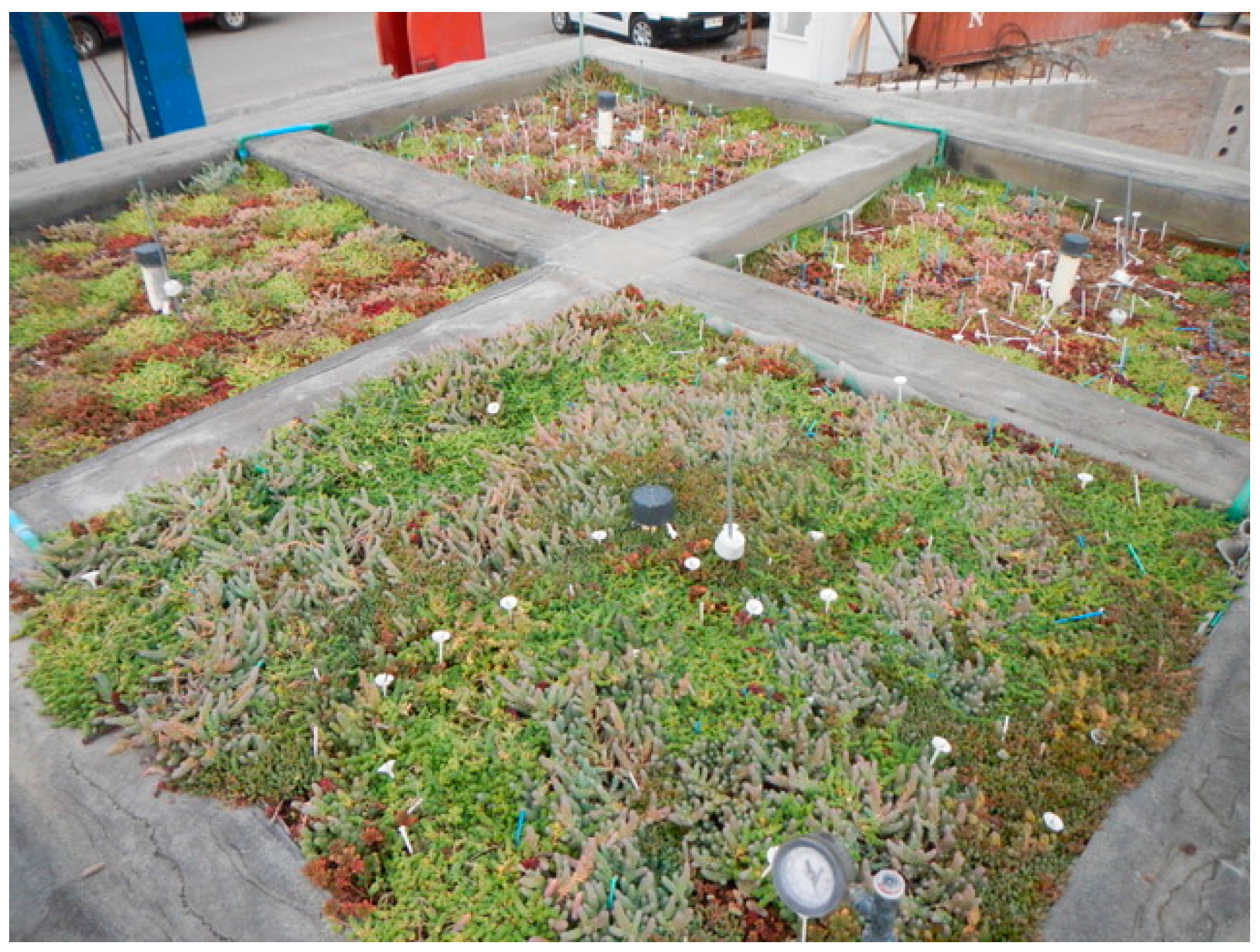
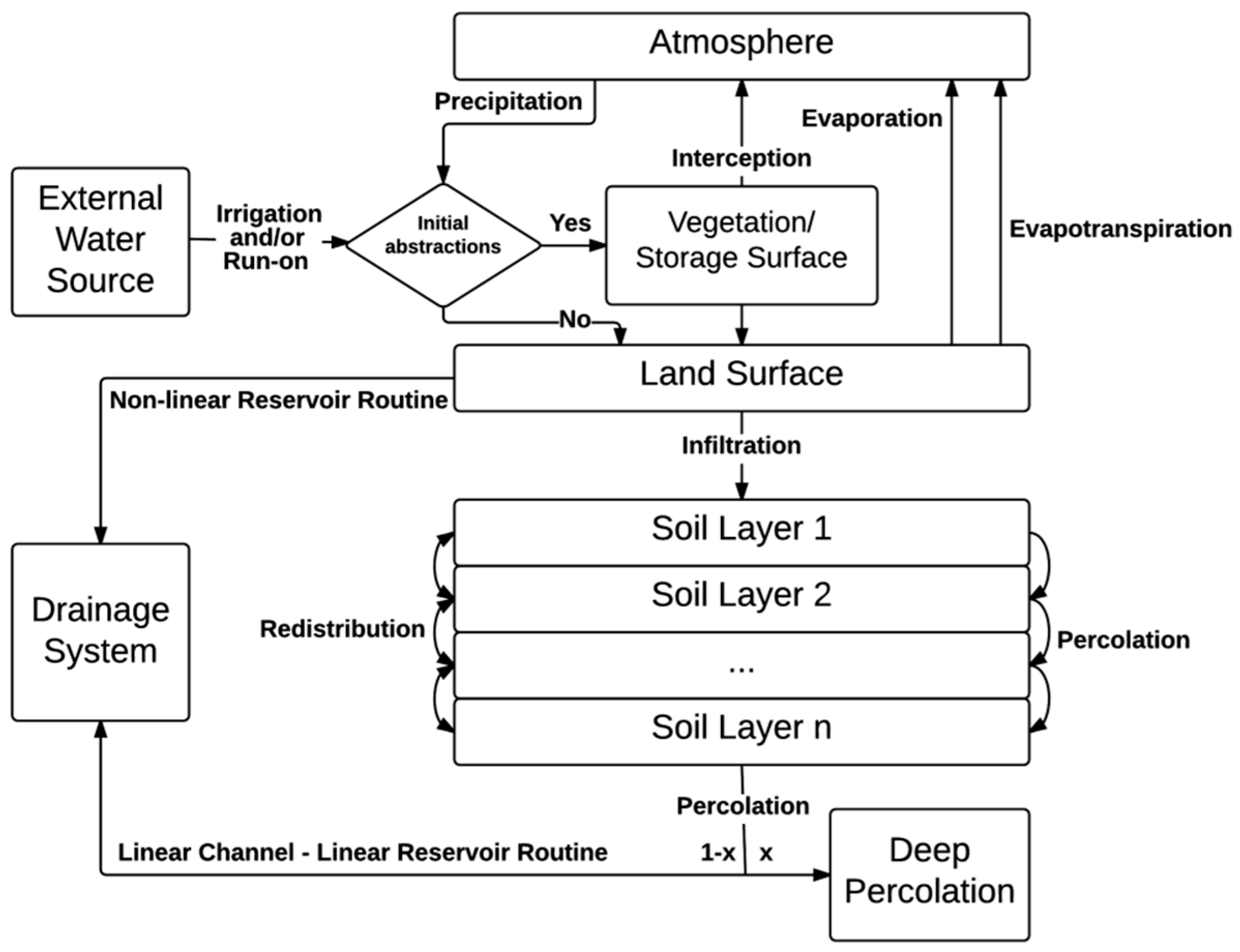
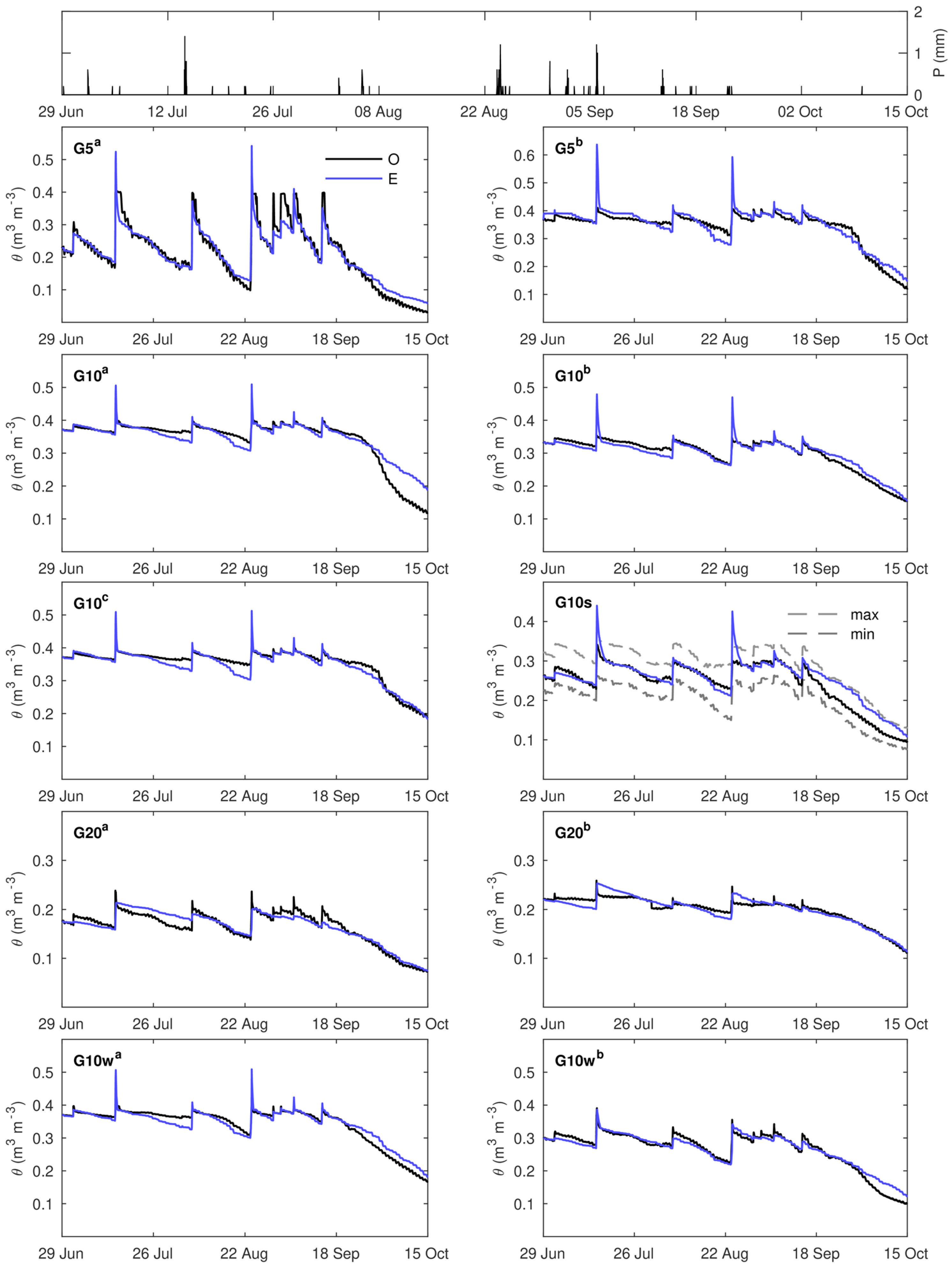
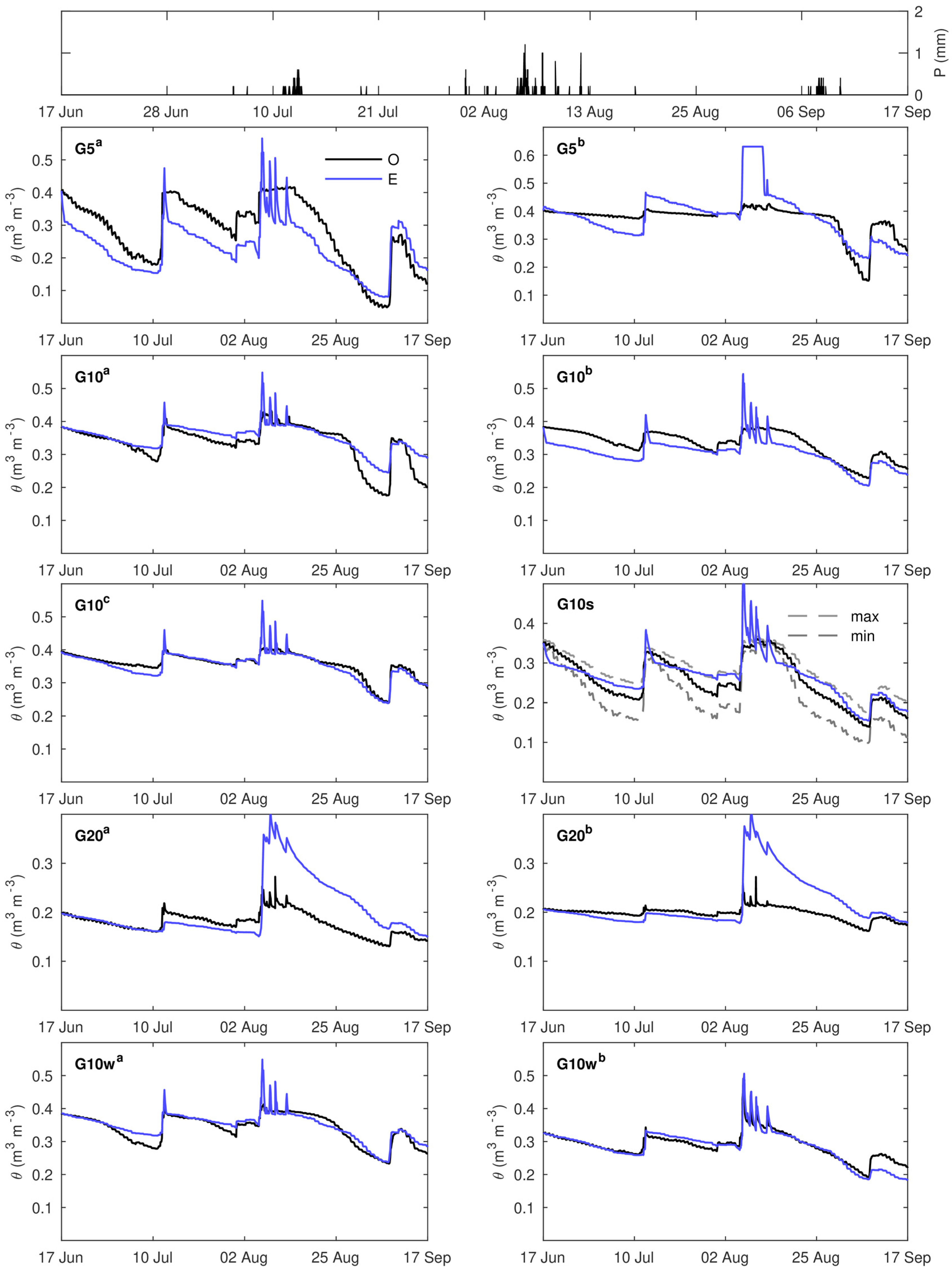
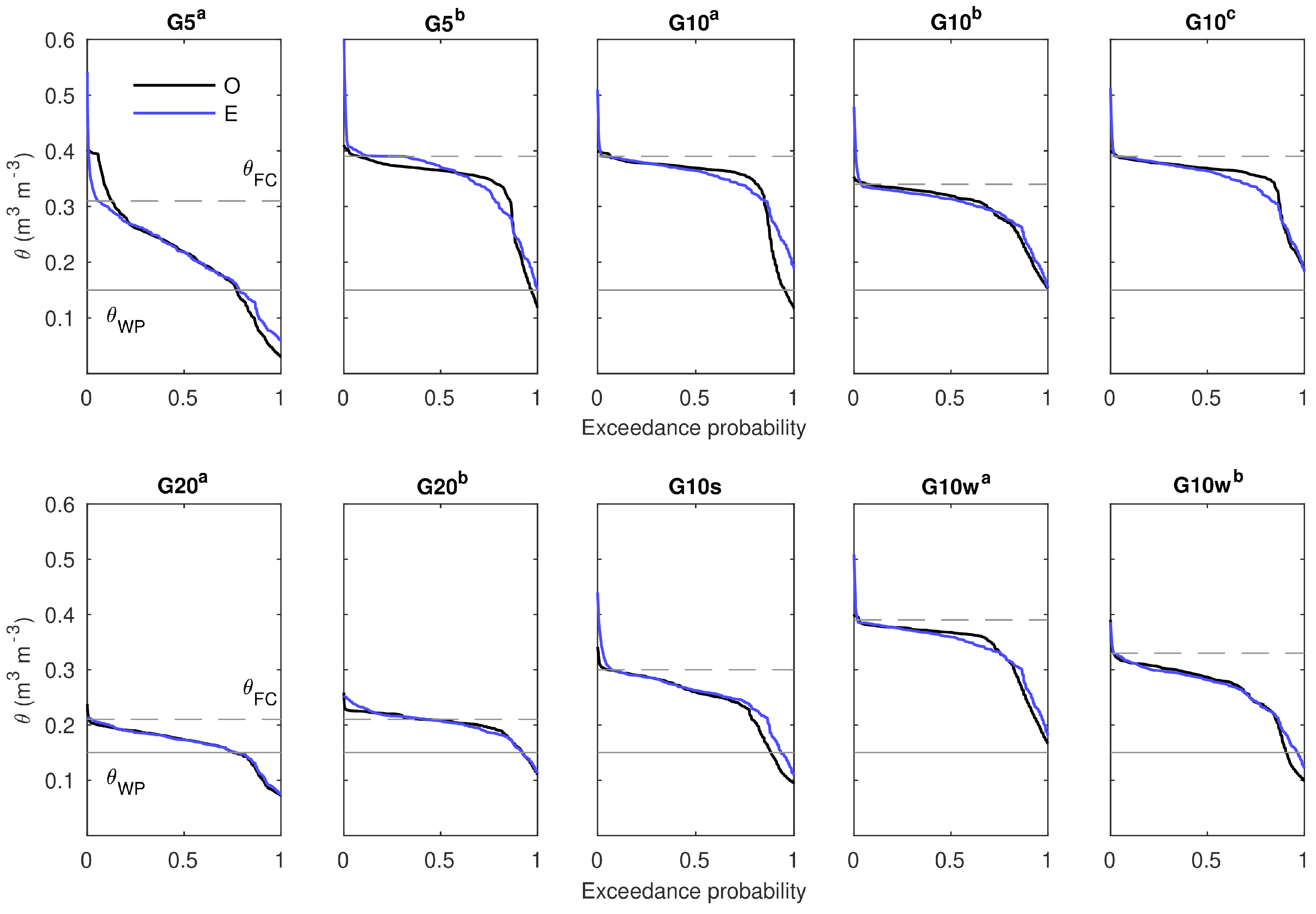

| Group | ID | Drainage System | Slope (%) | Substrate Depth (cm) |
|---|---|---|---|---|
| G5 | G5a | Sika® Sarnavert Aquadrain | 2 | 5 |
| G5b | Vydro® | 2 | 5 | |
| G10 | G10a | Sika® Sarnavert Aquadrain 550 | 2 | 10 |
| G10b | Delta®-Drain | 2 | 10 | |
| G10c | Vydro® | 2 | 10 | |
| G20 | G20a | N/A (Recycled) | 2 | 20 |
| G20b | Delta®-Floraxx | 2 | 20 | |
| G10s | G10sa | Delta®-Floraxx | 2 | 10 |
| G10sb | Delta®-Floraxx | 2 | 10 | |
| G10sc | Delta®-Floraxx | 2 | 10 | |
| G10w | G10wa | -- | 1 | 10 |
| G10wb | -- | 5 | 10 |
| Parameter | Value | Units |
|---|---|---|
| 0.010 | m3 m−3 | |
| 0.637 | m3 m−3 | |
| 1.44 | -- | |
| 0.5 | -- | |
| 145.1 | mm h−1 | |
| 85.5 | mm | |
| 0.15 | m3 m−3 | |
| 11 | mm | |
| 2.180 | -- | |
| 0.540 | -- |
| Group | ID | Substrate | Vegetation | ||
|---|---|---|---|---|---|
| (m3 m−3) | (m3 m−3) | (%) | S (mm) | ||
| G5 | G5a | 0.228 | 0.31 | 56.6 | 7.8 |
| G5b | 0.368 | 0.39 | 73.1 | 20 | |
| G10 | G10a | 0.371 | 0.39 | 85.3 | 8.3 |
| G10b | 0.333 | 0.34 | 90.7 | 11.3 | |
| G10c | 0.371 | 0.39 | 82.9 | 7 | |
| G20 | G20a | 0.175 | 0.21 | 95.7 | 50 |
| G20b | 0.220 | 0.21 | 95.7 | 44.4 | |
| G10s | G10s | 0.261 | 0.30 | 81.4 | 13.9 |
| G10w | G10wa | 0.370 | 0.39 | 84.2 | 7.7 |
| G10wb | 0.299 | 0.33 | 84.2 | 38.3 | |
| Group | ID | MCE | MAE | (VWC) | (VWC) | ||
|---|---|---|---|---|---|---|---|
| O | E | O | E | ||||
| G5 | G5a | 0.76 | 0.02 | 0.212 | 0.211 | 0.091 | 0.074 |
| G5b | 0.56 | 0.02 | 0.342 | 0.355 | 0.064 | 0.060 | |
| G10 | G10a | 0.64 | 0.02 | 0.343 | 0.348 | 0.070 | 0.047 |
| G10b | 0.71 | 0.01 | 0.299 | 0.299 | 0.049 | 0.044 | |
| G10c | 0.69 | 0.01 | 0.352 | 0.346 | 0.049 | 0.049 | |
| G20 | G20a | 0.66 | 0.01 | 0.164 | 0.165 | 0.034 | 0.033 |
| G20b | 0.64 | 0.01 | 0.201 | 0.200 | 0.026 | 0.028 | |
| G10s | G10s | 0.65 | 0.02 | 0.244 | 0.255 | 0.058 | 0.049 |
| G10w | G10wa | 0.73 | 0.01 | 0.342 | 0.342 | 0.056 | 0.048 |
| G10wb | 0.76 | 0.01 | 0.265 | 0.267 | 0.059 | 0.049 | |
| Group | ID | (m3 m−3) | MCE | MAE | (VWC) | (VWC) | ||
|---|---|---|---|---|---|---|---|---|
| O | E | O | E | |||||
| G5 | G5a | 0.405 | 0.25 | 0.06 | 0.282 | 0.233 | 0.102 | 0.076 |
| G5b | 0.403 | −0.24 | 0.04 | 0.371 | 0.382 | 0.054 | 0.087 | |
| G10 | G10a | 0.383 | 0.48 | 0.02 | 0.334 | 0.351 | 0.058 | 0.039 |
| G10b | 0.383 | 0.11 | 0.03 | 0.332 | 0.305 | 0.041 | 0.041 | |
| G10c | 0.395 | 0.59 | 0.01 | 0.357 | 0.352 | 0.034 | 0.040 | |
| G20 | G20a | 0.197 | −0.96 | 0.03 | 0.178 | 0.211 | 0.022 | 0.053 |
| G20b | 0.206 | −2.50 | 0.03 | 0.198 | 0.218 | 0.012 | 0.050 | |
| G10s | G10s | 0.350 | 0.55 | 0.02 | 0.256 | 0.267 | 0.058 | 0.053 |
| G10w | G10wa | 0.385 | 0.67 | 0.01 | 0.340 | 0.348 | 0.044 | 0.040 |
| G10wb | 0.325 | 0.60 | 0.01 | 0.288 | 0.285 | 0.039 | 0.049 | |
| N° | 1 | 2 | 3 | 4 | 5 | 6 | 7 | 8 | 9 | 10 | 11 | 12 | 13 | 14 | 15 | 16 | 17 | 18 | 19 | 20 | Total | |
|---|---|---|---|---|---|---|---|---|---|---|---|---|---|---|---|---|---|---|---|---|---|---|
| Initial Date (Day-Month-Year) | 02-07-2014 | 14-07-2014 | 03-08-2014 | 06-08-2014 | 23-08-2014 | 30-08-2014 | 01-09-2014 | 05-09-2014 | 13-09-2014 | 22-09-2014 | 05-07-2015 | 11-07-2015 | 30-07-2015 | 02-08-2015 | 05-08-2015 | 09-08-2015 | 12-08-2015 | 06-09-2015 | 07-09-2015 | 09-09-2015 | ||
| Precipitation (mm) | 7.0 | 35.6 | 2.2 | 15.6 | 35.2 | 7.0 | 7.2 | 11.8 | 13.8 | 1.6 | 1.2 | 31.0 | 6.0 | 1.6 | 100.6 | 8.2 | 10.8 | 1.0 | 15.4 | 1.8 | 314.6 | |
| Duration (days) | 0.2 | 0.3 | 0.1 | 0.2 | 1.6 | 0.1 | 0.3 | 0.3 | 0.4 | 0.6 | 0.1 | 2.0 | 0.4 | 0.1 | 3.1 | 0.4 | 0.2 | 0.2 | 1.0 | 0.1 | 11.7 | |
| Mean intensity (mm h−1) | 1.9 | 4.5 | 0.8 | 2.8 | 0.9 | 3.8 | 1.0 | 2.0 | 1.6 | 0.1 | 1.3 | 0.7 | 0.6 | 0.5 | 1.4 | 0.9 | 2.2 | 0.2 | 0.7 | 1.0 | 1.1 | |
| Max intensity (mm h−1) | 7.2 | 16.8 | 4.8 | 7.2 | 14.4 | 9.6 | 7.2 | 14.4 | 7.2 | 2.4 | 2.4 | 7.2 | 7.2 | 2.4 | 14.4 | 9.6 | 12.0 | 2.4 | 4.8 | 4.8 | 16.8 | |
| Dry days | 19.6 | 12.2 | 19.4 | 2.8 | 17.1 | 5.1 | 2.0 | 3.5 | 8.1 | 8.1 | 64.4 | 5.4 | 17.8 | 1.9 | 3.1 | 1.1 | 2.3 | 24.6 | 0.7 | 1.5 | 220.7 | |
| (m3 m−3) | G5a | 0.21 | 0.17 | 0.17 | 0.17 | 0.10 | 0.23 | 0.28 | 0.29 | 0.19 | 0.17 | 0.20 | 0.18 | 0.25 | 0.33 | 0.31 | 0.41 | 0.41 | 0.05 | 0.05 | 0.25 | -- |
| G5b | 0.36 | 0.36 | 0.35 | 0.35 | 0.31 | 0.36 | 0.38 | 0.38 | 0.36 | 0.35 | 0.38 | 0.37 | 0.38 | 0.39 | 0.39 | 0.41 | 0.41 | 0.16 | 0.15 | 0.35 | -- | |
| G10a | 0.37 | 0.36 | 0.36 | 0.36 | 0.33 | 0.37 | 0.38 | 0.38 | 0.36 | 0.36 | 0.31 | 0.28 | 0.32 | 0.34 | 0.33 | 0.39 | 0.39 | 0.18 | 0.18 | 0.34 | -- | |
| G10b | 0.33 | 0.32 | 0.31 | 0.31 | 0.26 | 0.31 | 0.33 | 0.33 | 0.29 | 0.28 | 0.33 | 0.31 | 0.30 | 0.33 | 0.33 | 0.37 | 0.38 | 0.23 | 0.23 | 0.30 | -- | |
| G10c | 0.37 | 0.36 | 0.36 | 0.36 | 0.35 | 0.37 | 0.38 | 0.38 | 0.36 | 0.35 | 0.35 | 0.35 | 0.35 | 0.37 | 0.36 | 0.39 | 0.39 | 0.24 | 0.24 | 0.35 | -- | |
| G20a | 0.17 | 0.16 | 0.16 | 0.16 | 0.14 | 0.18 | 0.19 | 0.19 | 0.16 | 0.15 | 0.17 | 0.16 | 0.17 | 0.18 | 0.18 | 0.21 | 0.21 | 0.13 | 0.13 | 0.16 | -- | |
| G20b | 0.22 | 0.22 | 0.20 | 0.20 | 0.19 | 0.21 | 0.21 | 0.21 | 0.20 | 0.19 | 0.20 | 0.19 | 0.19 | 0.20 | 0.20 | 0.21 | 0.21 | 0.16 | 0.16 | 0.19 | -- | |
| G10s | 0.25 | 0.23 | 0.25 | 0.26 | 0.23 | 0.28 | 0.29 | 0.29 | 0.24 | 0.21 | 0.22 | 0.21 | 0.22 | 0.24 | 0.23 | 0.34 | 0.35 | 0.14 | 0.14 | 0.21 | -- | |
| G10wa | 0.37 | 0.36 | 0.36 | 0.36 | 0.31 | 0.37 | 0.37 | 0.38 | 0.35 | 0.33 | 0.29 | 0.28 | 0.31 | 0.35 | 0.35 | 0.39 | 0.39 | 0.24 | 0.23 | 0.33 | -- | |
| G10wb | 0.29 | 0.28 | 0.28 | 0.28 | 0.22 | 0.29 | 0.30 | 0.30 | 0.26 | 0.24 | 0.27 | 0.26 | 0.27 | 0.29 | 0.29 | 0.34 | 0.34 | 0.20 | 0.19 | 0.26 | -- | |
| G5a | 0.00 | 0.65 | 0.00 | 0.24 | 0.59 | 0.00 | 0.03 | 0.46 | 0.17 | 0.00 | 0.00 | 0.50 | 0.00 | 0.00 | 0.87 | 1.75 | 0.91 | 0.00 | 0.00 | 0.10 | 0.58 | |
| G5b | 0.00 | 0.44 | 0.00 | 0.00 | 0.25 | 0.00 | 0.00 | 0.00 | 0.00 | 0.00 | 0.00 | 0.10 | 0.00 | 0.00 | 0.48 | 3.84 | 0.97 | 0.00 | 0.00 | 0.00 | 0.38 | |
| G10a | 0.00 | 0.66 | 0.00 | 0.21 | 0.55 | 0.00 | 0.09 | 0.39 | 0.21 | 0.00 | 0.00 | 0.43 | 0.00 | 0.00 | 0.87 | 1.75 | 0.95 | 0.00 | 0.00 | 0.00 | 0.57 | |
| G10b | 0.13 | 0.60 | 0.00 | 0.15 | 0.49 | 0.00 | 0.00 | 0.29 | 0.14 | 0.00 | 0.00 | 0.39 | 0.00 | 0.00 | 0.84 | 1.80 | 0.94 | 0.00 | 0.00 | 0.00 | 0.54 | |
| G10c | 0.02 | 0.70 | 0.00 | 0.25 | 0.57 | 0.00 | 0.17 | 0.44 | 0.25 | 0.00 | 0.00 | 0.48 | 0.00 | 0.00 | 0.89 | 1.75 | 0.95 | 0.00 | 0.00 | 0.00 | 0.60 | |
| G20a | 0.05 | 0.05 | 0.08 | 0.05 | 0.02 | 0.03 | 0.05 | 0.05 | 0.03 | 0.22 | 0.00 | 0.00 | 0.00 | 0.00 | 0.20 | 1.70 | 1.69 | 0.00 | 0.00 | 0.00 | 0.18 | |
| G20b | 0.14 | 0.13 | 0.11 | 0.04 | 0.03 | 0.04 | 0.06 | 0.05 | 0.00 | 0.00 | 0.00 | 0.00 | 0.00 | 0.00 | 0.23 | 1.36 | 1.65 | 0.00 | 0.00 | 0.00 | 0.19 | |
| G10s | 0.00 | 0.47 | 0.00 | 0.06 | 0.40 | 0.00 | 0.00 | 0.21 | 0.07 | 0.00 | 0.00 | 0.31 | 0.00 | 0.00 | 0.78 | 2.13 | 0.95 | 0.00 | 0.00 | 0.00 | 0.48 | |
| G10wa | 0.04 | 0.68 | 0.00 | 0.23 | 0.56 | 0.00 | 0.13 | 0.41 | 0.23 | 0.00 | 0.00 | 0.47 | 0.00 | 0.00 | 0.88 | 1.76 | 0.95 | 0.00 | 0.00 | 0.00 | 0.59 | |
| G10wb | 0.00 | 0.19 | 0.00 | 0.00 | 0.06 | 0.00 | 0.00 | 0.00 | 0.00 | 0.00 | 0.00 | 0.03 | 0.00 | 0.00 | 0.61 | 1.74 | 0.88 | 0.00 | 0.00 | 0.00 | 0.30 | |
© 2018 by the authors. Licensee MDPI, Basel, Switzerland. This article is an open access article distributed under the terms and conditions of the Creative Commons Attribution (CC BY) license (http://creativecommons.org/licenses/by/4.0/).
Share and Cite
Herrera, J.; Flamant, G.; Gironás, J.; Vera, S.; Bonilla, C.A.; Bustamante, W.; Suárez, F. Using a Hydrological Model to Simulate the Performance and Estimate the Runoff Coefficient of Green Roofs in Semiarid Climates. Water 2018, 10, 198. https://doi.org/10.3390/w10020198
Herrera J, Flamant G, Gironás J, Vera S, Bonilla CA, Bustamante W, Suárez F. Using a Hydrological Model to Simulate the Performance and Estimate the Runoff Coefficient of Green Roofs in Semiarid Climates. Water. 2018; 10(2):198. https://doi.org/10.3390/w10020198
Chicago/Turabian StyleHerrera, Josefina, Gilles Flamant, Jorge Gironás, Sergio Vera, Carlos A. Bonilla, Waldo Bustamante, and Francisco Suárez. 2018. "Using a Hydrological Model to Simulate the Performance and Estimate the Runoff Coefficient of Green Roofs in Semiarid Climates" Water 10, no. 2: 198. https://doi.org/10.3390/w10020198






